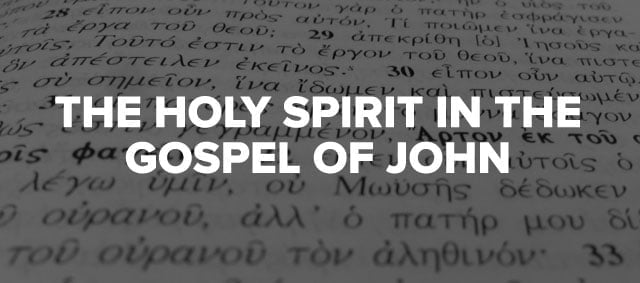⏱️ Estimated Reading Time: 22 min read
The Synoptic Gospels have little to say when considering the person and work of the Holy Spirit. In the Fourth Gospel, the Evangelist spends three chapters (John 14-16) teaching on the Holy Spirit’s role in the life of the believer. The Gospel of John may be criticized on its structure and genre, but it is beyond dispute that John demonstrates a deep understanding of the Old Testament. Today, I will cover three sections the work of the Holy Spirit, the person of the Holy Spirit, and receiving of the Holy Spirit. It is the Holy Spirit’s role in the life of the believer to convict of sin, glorify the person of Jesus, and transform believers into the image of the Lord Jesus Christ.
The Work of the Holy Spirit
John 1:33: The Spirit descending as a Dove
The Holy Spirit descending on Jesus as a Dove is a sign of His divine anointing. “In the Synoptic Gospels, the descent of the Spirit as a dove was something Jesus Himself witnessed (Mt. 3:16), a symbol in tandem with the voice from heaven….Here in the Fourth Gospel, however, the dove assumes a different role: it identifies the Coming One to John the Baptist.”1 John the Baptist had been told by God Himself who the Promised Messiah would be “‘He on whom you see the Spirit descend and remain, this is he who baptizes with the Holy Spirit’” (v.33).
The Holy Spirit in the Old Testament came upon people to enable them to accomplish God-given tasks. An example of this is when Isaiah predicted that the Messiah would be full of the Spirit at all times (Isa. 11:2; 61:1; Luke 4:18). Christians reading Isaiah 11:1 “saw in Jesus the fulfillment of God’s promises to pour out his Spirit on the coming Davidic king, on the Servant of the Lord (Is. 42:1) and on the prophet-figure”2 who announces, “The Spirit of the Lord God is upon me, because the Lord has anointed me to bring good news to the poor” (Is. 61:1). “The visible descent of the Spirit on Jesus served as the God-given sign by which the Baptist would know that this was the long-awaited Coming One…The Spirit not only descends on Jesus, but remains on him…“That Jesus would baptize his people in the Holy Spirit is therefore simultaneously an attestation of who he is, and an announcement that the promised age is dawning…For the Evangelist, then, the aspect of Jesus’ baptism that suited his purpose in writing was its role in bringing the Baptist to recognize who Jesus was, and therefore to hear witness specifically to him, and no longer to an unidentified ‘Coming One.”3
John 3:6; 6:33: The Spirit as the Giver of Life
John 3:6 and 6:33 view the Holy Spirit as the giver of eternal life. John 3:6 states, “That which is born of the flesh is flesh, and that which is born of the Spirit is spirit.” John 6:33 says, “For the bread of God is he who comes down from heaven and gives life to the world.” John 3:36 and John 6:33 teach that it is the Holy Spirit’s work to give new life. Merrill Tenney explains, “The new life of one born of the Spirit is unexplainable by ordinary reasoning, and the outcome is unpredictable.”4 “The flesh does not mean the same thing as when Paul assigns it, ‘sinful nature’”5 “As in, John 1:14, ‘flesh’ refers to human nature, the point is that natural, human birth produces people who belong to the earthly family of humankind, but not to the children of God…It is the Holy Spirit who produces new nature, a spirit-nature where ‘spirit’ is related to the sphere of God and things divine. In order for those born of flesh to experience the new birth that makes them children of God, the eternal Word had to become flesh. Nicodemus should have understood the need for a God-given new birth, and God’s promise that He would give his people a new heart, a new nature, clean lives and a full measure of the spirit on the last day.”6 This is why Nicodemus shouldn’t have been surprised when Jesus told him about the new birth.
“The bread of God is synonymous with the ‘bread of heaven…The bread of God reminds God’s people that this Bread is the revealer, the One who has narrated God to His people (1:18), the One who alone can tell them heavenly things (3:11-13), the One whose words, because He is the obedient Son, are nothing less than the words of God.”7
Jn. 3:8: The Spirit Sovereignly Acts
The sovereign character of regeneration is explained by an illustration taken from the action of wind in John 3:8. No one can direct the wind because it acts with complete independence. “The word breath or wind within “the spirit of man is that immaterial principle of life within him.”8 “The “Greek word “Pneuma and Ruach both mean spirit, wind, or breath.”9 “Nicodemus was brought up with “the belief that a person could and should save himself by perfect obedience to the Law of Moses and to a host of man-made, thoroughly analyzable, human regulations.”10
John 4:10: The Spirit as Living Water
“Jesus arouses the curiosity of the woman in order that her respect for him may increase, and the work of rescuing this soul from the fetters of sin and evil may make further progress.”11 While Jesus does not directly answer the woman’s question, He doesn’t ignore it either, but shows her that the question she asked is based on an erroneous presumption. The woman proceeds from the assumption: “You– a Jew– are needy and helpless—I, a Samaritan woman, am self-sufficient and therefore able to supply your need. Jesus by His answer shows her that she is the one who needs the Water that only He can supply.”12
Jesus’ words about “living water” involve double meaning, as the phrase refers to fresh spring water. John 7:38-39 identifies this “living water” as the Holy Spirit dwelling within a believer (Jer. 2:13; Ezek. 47:1-6; Zech. 14:8). “When Jesus speaks about living water He means spring-water which bubbles up by itself, in distinction from rain water, which must be collected in a cistern or reservoir…The metaphor speaks of God and his grace, knowledge of God, life, the transforming power of the Holy Spirit; in Isaiah 1:16-18; Ezekiel 36:25-27 water promises cleansing.”13
“In John’s Gospel there are passages where Jesus is the living water as he is the bread from heaven (6:35), and other passages where he gives the living water to believers. In this chapter, the water is the satisfying eternal life mediated by the Spirit that only Jesus, the Messiah and Savior of the world can provide.”14
John 4:23-24: Worshipping in Spirit and in Truth
“The verb will worship in the Fourth gospel never means will respect.”15 Worship worthy of the name of Jesus operates from a clear and definite knowledge of God derived from the revelation of His Word. “Worshipping the Lord in spirit and truth means rendering homage to God so that the entire heart enters into the act, and doing this in full harmony with the truth of God as revealed in His Word. Such worship will not only be spiritual instead of physical, but it will be directed to the true God as set forth in Scripture and as displayed in the work of redemption.”16
Some think that doctrinal soundness is of little importance, while some think that a humble, spiritual attitude means little. Genuine worshipers worship in spirit and truth. For such are the very people whom the Father is seeking as his worshipers, because “the Father keeps on intensely yearning for His elect in order to make them worshipers.” 17 The seeking of the Father is always saving (Luke 19:10), because it is God who takes the initiative in the work of salvation, never man (3:16; 6:37, 39, 44, 65; 15:16).
The necessity for distinctly spiritual worship is rooted in the very being of God: God is Spirit. “The predicate, Spirit, is the first word of the sentence, and is not preceded by the article. The predicated is placed first for the sake of emphasis: completely spiritual in his essence is God…God is not a stone-deity or tree-deity, neither is he a mountain. God is an independent, incorporeal, personal Being.”18 Hence, those who worship him must worship in spirit and truth.
Jesus places His own must over and against that of the woman (4:24 with 4:20), which means genuine worshipers must worship Him in spirit and truth. “The expression the true worshiper does not make a distinction between worshippers after the ministry of Jesus (the true worshipers and those before the ministry of Jesus (presumably the false worshippers).”19
Jn. 15:26: The Spirit of Truth Comes, Testifying of Christ
The Helper in John 15:26 is the Holy Spirit. “Whom I will send” indicates that the Holy Spirit will come in new power into the world in obedience to God the Son. “But who proceeds from the Father” indicates that the Holy Spirit will also come in obedience to the directions of God the Father. Both the Father and the Son sent the Holy Spirit into the world in a new fullness at Pentecost (Acts 2:1-33). “He will bear witness about me” reminds believers that when they bear witness about Christ, the Holy Spirit is working silently and invisibly through their words.
Jesus has been speaking about the hatred which the disciples will have to endure from the world, which hates the Father and the Son. Hence, it is not surprising that in this connection, He again comforts these men by reminding them of His previous promise (14:16-17, 26) with respect to the coming of the Spirit, the Helper. Jesus Himself will send this Helper. He will be sent from the Father. Essentially, though with difference in emphasis, this is the same as saying: “I will request the Father, and he will give you another Helper” (14:16)…”the Helper, the Holy Spirit, whom the Father will send in my name” (14:26).
“Here in 15:26 the emphasis is on the activity of the Son in the sending of the Spirit, and on the fact that this Spirit proceeds eternally from the Father…The sending of the Spirit, was a matter of the future as Pentecost had not yet arrived. Hence, the future tense is used: “I will send…The procession was taking place at the very moment when Jesus was speaking; hence, the present tense is used.”20
The Holy Spirit in John 14:17 is called The Spirit of truth. “The Holy Spirit testifies against the world (16:8-9) and to mankind’s need. That Spirit will testify (1:7-8). In the midst of the wicked world he will testify against the world (16:8-9). In the midst of the church he will comfort the Church.”21 “Whenever a servant of God bears witness bears witness against the world, this is witness is the work of the Spirit. Whenever a simple believer, by word and example, draws others to Christ, this too is the work of the Spirit. That Spirit always testifies in connection, with the word, the Word of Christ (14:16; 16:14-15).”22 The world is openly hostile to Christ and will not receive him (14:17).
From among those who are hostile to the truth about Jesus, some will be transferred from the Kingdom of Darkness to the Kingdom of the Lord Jesus Christ. One example of this is the fierce persecutor– Saul of Tarsus. The Spirit changed him to become a zealous missionary for Christ. The Holy Spirit glorifies Himself through the salvation of persecutors like Saul and many others who come to see the truth and beauty of Jesus Christ.
Jn. 16:7-14: The Spirit as the Advantageous Helper
Jesus “going away” in John 16:7 is important because while He was on earth, He could only be in one place at a time, but when He died and rose again, the Holy Spirit would carry on His ministry over the entire world at all times. In addition, in God’s sovereign plan for the unfolding of history, the Holy Spirit would not come in new covenant power and fullness until Jesus returned to heaven (7:39; 14:16-17; 15:26). “The Helper” refers back to the anticipation of the pouring out of the Spirit and the inauguration of the Kingdom spoken of in Old Testament prophetic literature. Dr. Köstenberger suggests that the term “helping presence” more accurately captures the term paraklétos, a reference to the Holy Spirit as helper in the Gospel of John.23
“He will convict the world” in John 16:8 gives hope that many who are in “the world” (and currently opposed to Jesus) will not be part of “the world” forever but will repent of their sins and believe in Christ. “The world “refuses to believe in Him.”24
“The Spirit convicts the world of its sinful condition, that is, the fact that it stands guilty before God.”25 Through the work of witnessing, which will be carried on by the apostles and their followers (15:27), the Holy Spirit will not only lay bare the world’s sin but in the case of some will awaken a consciousness of guilt which leads to true repentance (1 John 3:8).
“From Acts 2:22-41; 7:51-57; 9:1-6; 1 Cor. 14:24; 2 Cor. 2:15-16; Titus 1:13 one learns that in some cases the result will be conversion; in others, hardening and everlasting punishment.”26 Though the world in general continues to persecutes the Church (7:51), there will be millions of people in the course of history who are awakened to their sin and guilt. As a result of the operation of God’s sovereign grace, men from every tribe and nation will accept Jesus as their Lord and Savior.
When the Holy Spirit, through the preaching of the Gospel, convicts men of their sin, a considerable number of them will cry out, “Brethren, what shall we do?” (Acts 2:37). They will feel that the essence of their sin (the one great sin which embraces all others for those who have never heard the Gospel) is this: that they have not accepted Jesus as their Lord and Savior but have rejected him).
“Because I go to the Father” in John 16:10 means that Jesus will no longer be in the world to teach about true righteousness, and so the Holy Spirit will come to carry on that function, through illumination (v.13) and through the words of believers who bear witness to the Gospel. “Because the ruler of this world is judged” can also be “has judged”, because the perfect tense verb kerkritai (Gk.) has the sense of “has been judged and continues in the state resulting from that judgment.”
“The Spirit of Truth” in John 16:13 means that the “Holy Spirit leads into the whole body of redemptive revelation.”27 Since only God knows the future “the things to come” highlights the full deity of the Holy Spirit.
The point of John 16:14-15 is that “the Holy Spirit will glorify the Son.”28 The Holy Spirit will “take that which is Christ’s- the very substance of his teaching regarding the purpose of redemption, manner of salvation, etc.—and will enlarge on it. Whatever Christ has done, is doing, will do (for the Church) is the theme of the Holy Spirit’s teaching.”29
The Person of the Holy Spirit
Jn. 14:16: An Everlasting Comforter
“The person of the Holy Spirit refers to the attributes of emotions, will, volition, intelligence, sensibility, and personality, which relate to humanity.”30 John 14:17 makes it clear that the Helper spoken of in John 14:16 is the Spirit of truth. “The Holy Spirit is not merely a power but a person, just like the Father and the son. He is another Helper, not a different Helper.”31
“The word “another” indicates one like myself, who will take my place, do my work. Hence, if Jesus is a person, the Holy Spirit must be a person.32 “Personal attributes are everywhere ascribed to him (14:26; 15:26; Acts 15:28). His relation to the Father and the Son is described as of such a character that if these are persons, he too must be a person (Matt. 28:19; 1 Cor. 12:4-6,).”33
“If Jesus is divine, the Spirit, too, must be divine. Divine attributes are ascribed to the Holy Spirit: such as, eternity, omnipresence, omnipotence, omniscience (1 Cor. 2:10; 12:4-6) and divine works are predicated of him (Matt. 12:18; Luke 4:18). Matthew 28:19 and 2 Corinthians 13:14 make it clear that the three persons are completely equal. One and the same divine essence pervades all.”34
“The Holy Spirit is given by the Father, in answer to the request of the Son.”35 The Holy Spirit proceeds from both the Father and the Son. “The Father gives Him; the Son sends Him (15:26). He is the Spirit of the Father; is also the Spirit of Christ (Matt. 10:20; Rom. 8:8).36 “The Holy Spirit is the person in whom the Father and the Son meet one another. Moreover, here as elsewhere the economical trinity rests upon the ontological: the Spirit’s outpouring on the day of Pentecost, to which the present passage refers, rests upon his eternal procession. Both of these are the works of the Father and the Son.”37
The Spirit, in John 14:16, is called another Paraclete “a term meaning to be called to the side in order to help…The Father and the Son call the Spirit to the side of the disciples in order to comfort, admonish, teach and guide them; in other words, in order that in any given condition the Paraclete may furnish whatever help is necessary.”38 Jesus sends the Holy Spirit to not only comfort, teach and guide believers into all the truth, but to send them out on His mission of proclaiming the Gospel to further the kingdom of God. “Not only are Jesus and his disciples ‘sent’ in this Gospel, but so also is the Spirit ‘sent.’ The Spirit comes to represent and carry on Jesus’ work.”39
Jn. 14:17: The Spirit of Truth: Indwelling the Elect
Jesus taught His followers that the world cannot receive Him because they “cannot see or know him” (John 14:17). The world “cannot receive” the truth about Jesus because it follows Satan’s lies (8:44-45; 14:30). The world cannot “see him nor know him” because it fails to acknowledge the Spirit (Matt. 12:22-37; Acts 2:12-17). “The Holy Spirit guides his people into the truth which is embodied in Christ and his redemption.”40
The words “You know him, for he dwells with you and will be in you” are intimate and relational. According to Augustine, Christ dwelt physically with his disciples through the Holy Spirit, but also in an invisible way, as he explains commenting on John 14:17 that, “Nor can we have knowledge of Him unless He be in us.”41 Jesus knows the elect, those who are His, because He has opened their eyes to the truth about who He is, what He has done in His life, death, resurrection, and ascension, and now indwells them with the Holy Spirit granting them an everlasting intimate relationship with God, through Jesus Christ.
Jn. 14:26: The Teacher and Reminder of Christ
“But the Helper, the Holy Spirit, whom the Father will send in my name, he will teach you all things and bring to your remembrance all that I have said to you” (John 14:26).
“A comparison between John 14:26” whom the Father will send in my name” and 15:26, “whom I will send to you from the Father” makes it clear that the sending of the Holy Spirit at Pentecost (Acts 2) is ascribed to both the Father and the Son.”42 The promise here in this first contains two elements: everything or all things and being reminding of everything. First, “The Spirit will teach you everything that is necessary (not only for your salvation, but here specifically) for the work of witnessing (matt. 10:10; 1 John 2:27).”43 Second, “the Spirit will remind you of everything that I have myself said to you. By means of both of these Jesus Christ is fulfilling his prophetic office, first on earth, then from heaven.”44
“The two everything’s should be viewed as concentric circles, for also by means of recalling the old (“everything that I myself said to you”), the Spirit would be teaching the new.”45 “It must borne in mind that between the time when Jesus uttered these words and the moment when the Holy Spirit was poured out there occurred the following significant events: Christ’s crucifixion, resurrection, ascension, and coronation.”46 The Holy Spirit teaches believers about the truth about Jesus helping drill into them a deeper understanding of what they have received in the Word of God.
The Receiving of the Holy Spirit
Jn. 20:19-23: The Spirit is Received
Some people take “the doors being locked” in John 20:19 to imply that Jesus miraculously passed through the door of the walls of the room even though the text does not explicitly say this. It is better to see this passage as teaching that “Jesus literally came and stood before in their midst.”47
John 20:21-22 contains the Johannine “Great Commission,” which serves as the culmination of the entire Gospel’s presentation of Jesus as the One sent from the Father (3:17). The Sent One (Jesus has now become the Sender, commissioning His followers to serve as His messengers and representatives). All three persons of the Godhead are involved in this commissioning: as the Father sent Jesus, so Jesus sends His disciples (20:21), equipping them with the Holy Spirit (v.22). When Jesus “breathed on them” and said, “Receive the Holy Spirit,” is best understood as a foretaste of what would happen when the Holy Spirit was given at Pentecost (Acts 2). This does not mean that the Holy Spirit had no presence in the disciples’ lives prior to this point (John 7:39; 14:16-17).
Conclusion
The work and person of the Holy Spirit in John’s Gospel is grounded in the Old Testament. The Holy Spirit is the One who convicts of sin, glorifies the person of Jesus and transforms believers into the image of the Lord Jesus Christ. The Holy Spirit convicts people of their sin and points them towards Jesus in order that they may with confidence “draw near to the throne of grace to receive mercy and find grace in time of need” (Hebrews 4:16). This paper examined the person, work and receiving of the Holy Spirit, who acts sovereignly to gives life, indwells and teaches the elect in order deepen their understanding of the work of Jesus and then sends them out to testify about the glory of Jesus. John has intentionally demonstrated in his Gospel a view of the Holy Spirit that is relational, personal and intimate: One who longs to breathe new life into those who come to Jesus and to sanctify the Beloved in the Word by washing them with the sanctifying power of the Word of God.
For further study in the Gospel of John one should consider exploring the Greek word Paraclete and the seven “I AM” statements. Concerning the role of the Holy Spirit for further study one should consider studying the relationship of John’s view of the Holy Spirit with that of the Book of Acts and his understanding and use of the Old Testament in his Gospel. Scholars of John have long noted that John is an artist weaving his story with increasing intensity and passion to get his readers to understand who Jesus is, what He has done, and what He now demands. John’s Gospel is a never ending oasis that beckons Christians to study it in order to help them to grow in the truth, beauty and glory of Jesus. God’s people through the work of the Holy Spirit are enabled to know and make known the supremacy of Jesus in the power of the Holy Spirit.
References
Dave Jenkins is happily married to his wife, Sarah. He is a writer, editor, and speaker living in beautiful Southern Oregon. Dave is a lover of Christ, His people, the Church, and sound theology. He serves as the Executive Director of Servants of Grace Ministries, the Executive Editor of Theology for Life Magazine, the Host and Producer of Equipping You in Grace Podcast, and is a contributor to and producer of Contending for the Word. He is the author of The Word Explored: The Problem of Biblical Illiteracy and What To Do About It (House to House, 2021), The Word Matters: Defending Biblical Authority Against the Spirit of the Age (G3 Press, 2022), and Contentment: The Journey of a Lifetime (Theology for Life, 2024). You can find him on Facebook, Twitter, Instagram, Youtube, or read his newsletter. Dave loves to spend time with his wife, going to movies, eating at a nice restaurant, or going out for a round of golf with a good friend. He is also a voracious reader, in particular of Reformed theology, and the Puritans. You will often find him when he’s not busy with ministry reading a pile of the latest books from a wide variety of Christian publishers. Dave received his M.A.R. and M.Div through Liberty Baptist Theological Seminary.




